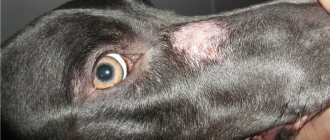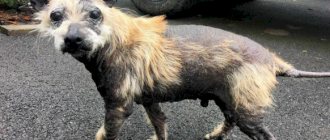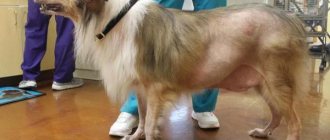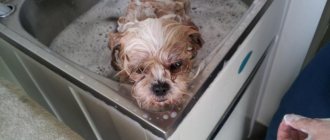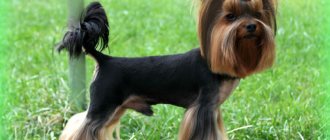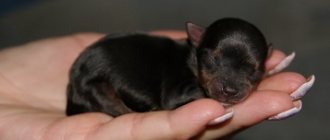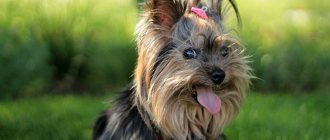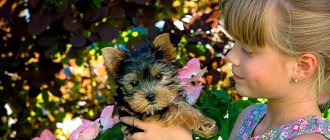In this article we will look at what types of Yorkshire terrier coat , the color standard and the features of caring for the Yorkie's coat .
It must be remembered that the skin and coat of the Yorkshire Terrier should become the object of constant attention from the owner, because they not only reflect our aesthetic perception of the dog, but also indicate its health.
Length, density, color, shine primarily depend on hereditary factors. Please note that all the dog’s closest ancestors must have a coat of the correct structure, which reaches floor length at 15-20 months. That is, with the height of an adult Yorkie being 20-26 cm at the withers, the growth rate of the coat should be at least 15-20 mm per month.
It is worth noting that during certain periods of a Yorkie’s life, the rate of fur growth changes. It slows down during the puppy's teeth change, during the bitch's heat and pregnancy, and also during the feeding period of the puppies. Illness or stress can also cause slow fur growth. The rate of fur growth in a young dog is much greater than in an adult dog.
The key to good hair growth in a dog is proper nutrition and health . The beauty of wool, first of all, like that of a person, depends not on cosmetics, but on the internal state. Of course, high-quality cosmetics can improve the quality of the coat, add shine, and eliminate fragility. But this is a cosmetic effect, you need to remember this. Give your pet the right diet, take care of his health, and you will get wonderful coat and a real show dog!
The environment also affects the quality of wool. So, we must take into account that the sun's rays have an adverse effect on wool. Salty sea water negatively affects the quality of wool. Too dry indoor air contributes to dry skin and brittle hair. You should not allow your Yorkie to lie near the battery. In winter, when heating devices are actively working, it is good to use air humidifiers.
What is important for the owner to know
Yorkies are very fragile creatures . On average, this dog breed lives from 12 to 14 years. An adult animal should weigh no more than 3170 grams.
The Yorkshire Terrier is very friendly and can quickly form friendships with people or animals. He is devoted to the owner , an attentive listener. It has long been known that Yorkies have a positive effect on the psyche.
This breed of dog does not shed and does not have a specific odor.
If you buy a Yorkshire Terrier puppy without the help of a specialist, you need to pay attention to the following features:
- The “calling card” of a real Yorkshire Terrier is its brand.
- The legs should be straight and the back should be level.
- The wool and skin are clean; if the wool looks like cotton wool, you will have to suffer with it.
- The eyes, nose and ears should not be damaged or inflamed.
- There should be six teeth below and six below, a scissor bite.
How often to walk
A Yorkie puppy should be taught to walk gradually, first he is taken outside in his arms and walked for a short time, after a while you can start carrying him in a bag. And only when he gets used to it, you can put the puppy on the grass for a while if the weather is good outside.
only walk with this curious dog . A walk of about an hour a day is enough to satisfy your Yorkie's need for activity.
Although Yorkies have long hair, they do not provide warmth due to the lack of undercoat. special overalls and shoes for walks .
What physical activity does a dog need?
Your Yorkie should receive some physical activity every day. Games are suitable for this, so you need to make sure that the dog plays and runs .
What troubles can happen to a Yorkshire Terrier?
Yorkies are brave, curious and fearless. Recklessly brave puppies, chasing something, can jump out onto the road or fall under the feet of a person or the wheels of a stroller.
Therefore, in order to avoid trouble, you should definitely control their movement .
It is imperative to teach the puppy basic commands , since without them you can lose the puppy. They are easy to train, but this requires a strong owner, as these dogs are very ambitious.
Description of the Yorkshire Terrier breed
These are small dogs with a very strong build. According to the standard, the weight of a Yorkshire Terrier should not exceed 3.2 kg. There is no minimum limit. However, it has been noted that how long Yorkshire terriers live at home seriously depends not only on care and nutrition, but also on the weight of the pet. The less a dog weighs, the shorter its life expectancy. Therefore, the desire to choose a miniature Yorkie for keeping in an apartment is a tribute to fashion, not common sense. According to the breed standard, representatives that are too small are considered a breeding defect and are prohibited from being used for mating, breeding, or participating in exhibitions.
pixabay.com/
The compactness of Yorkies is complemented by their grace and even a certain pride in their gait. They have a small head with triangular, high-set ears, a short muzzle, a regular bite and dark, shiny, small eyes. Breeders say that the dog's gaze is intelligent and alert. And even just by the “expression” of the muzzle one can distinguish a real Yorkshire terrier from its baby-face “variety”.
This is the name given to Yorkie dogs with a particularly short muzzle and bulging, as if surprised, “childish” eyes. These babies look, of course, touchingly, but they don’t fit into the standard. Experts give preference to the “classic” structure of the Yorkshire Terrier’s muzzle, while the baby face is considered a defect.
The body structure of the Yorkie is noticeable: an absolutely straight back, a narrow chest and completely straight hind legs. It used to be customary to dock the tail, but today the right to shorten it or leave it as is is given to the discretion of the breeder. Therefore, more and more Yorkies are appearing with medium-length tails, which are usually raised to the same level as the back line and end in a fun tassel.
pixabay.com/
How to care for a newly purchased puppy
Even before the puppy arrives, you need to take care of the necessary care items and prepare the place. In a new home, the terrier may be frightened by the new environment, but gradually he will begin to get used to it and master the territory.
What to buy for a puppy
It is better to buy all products for the maintenance and care of the Yorkshire Terrier in pet stores or at large exhibitions.
For York you will need:
- enclosure (to create a cozy and safe place in the puppy’s home);
- bed;
- carrying bag;
- collar with leash and tape measure;
- bowls, at least two pieces;
- feeder and drinking bowl (necessarily heavy, ceramic or earthenware);
- latex and edible toys made from veins (bones, balls, squeakers);
- specialized cosmetics (shampoos, balms, sprays);
- Terry towel;
- combs of several types: metal with a comfortable handle and frequent rounded teeth; massage brushes;
- papillots with elastic bands;
- small scissors with rounded ends, which are convenient for trimming the hair on the ears and between the toes;
- nail clippers or nail clippers;
- file for sharpening claws;
- various clothes;
- bows, hairpins and various accessories for creating hairstyles
Prepare your apartment for the arrival of a dog
For the puppy, you need to secure the quietest place in the house. Do not give him a place where drafts . You cannot assign the puppy a place near the radiator, in the corridor where people often walk.
Remove all small toys and things from the house that an inquisitive dog might chew or swallow. It is better to purchase a special playpen, the dog will be safe in it, but do not put it in a dark corner. Give your Yorkie a bed to sleep on.
How to prepare a place where the dog will rest?
You can sew a puppy bed yourself by filling it with padding polyester or furniture foam rubber . Removable covers are a must. Specialized stores sell sun loungers with sides or in the shape of a house. Dogs feel more protected on them.
How to train to the tray
It’s not difficult to train a Yorkie to sit on a tray, but at first you will have to suffer a little. Be patient , if you scold and punish him, you can upset the dog’s psyche.
Little Yorkies relieve themselves after eating and sleeping. This is the time to plant them. Stand in front of him until he empties. After this, be sure to praise him . Soon the dog will learn to cope with this matter on its own.
And if your pet continues to misbehave at home, then read our detailed recommendations on how to wean him off it.
Basic rules for keeping a Yorkie
To prevent diseases, do not forget to examine the terrier daily ; if there is any abnormality, the puppy must be shown to a veterinarian.
A normal, standard, healthy Yorkshire Terrier typically weighs between 2 and 3 kg. The temperature, which is measured through the anus, should be 38-39 degrees.
What are the problems and diseases?
In the process of breeding a Yorkie, the following diseases are most often noticed:
- Dermatitis, alopecia and other skin diseases. With dermatitis, tumors and fever appear. Alopecia causes patchy hair loss, usually on the scalp.
- Eye diseases such as cataracts and glaucoma. They can appear due to improper care, after which the dog’s eyes become cloudy.
- Displacement of the joints of the limbs. Patella dislocations. They are usually congenital.
- Diseases of the joints of the limbs, fractures, etc. Because of them, the dog begins to limp.
- Kidney disease, with frequent urination and thirst. The dog is losing weight, although her appetite remains good.
- Allergy.
- Non-closure of the fontanel. By the time the dog is one year old, it should be closed.
- Spasm of the pharynx, which makes breathing difficult, leading to suffocation.
- Hernia.
When to get vaccinated?
Vaccinations will help keep your pet healthy. The first vaccination is given at 6 weeks, then repeated after two or four weeks. The next vaccination is scheduled for the year when all the teeth are replaced.
Then one vaccination is given per year. Two weeks before vaccination, it is necessary to carry out procedures to expel worms.
Grooming
All Yorkies have long, beautiful hair that requires constant care. It is necessary to comb the fur. You can give your dog a model haircut, but most owners like to do their pet’s hair themselves.
How often should I bathe?
Your Yorkie should be washed three times a month . It's better to bathe him in the bath. You should not use too much pressure from the shower, as the puppy may be frightened by the strong jet. The water temperature should be 35-36˚C. It is better to take a special shampoo or use a children's shampoo, but they must be diluted with water.
After the dog has been washed, apply conditioner to the fur and rinse it thoroughly. To prevent the wool from becoming tangled, all actions are carried out in the direction of the hair .
After washing your Yorkie, wrap it in a soft terry towel and dry it with a warm hairdryer . When the fur is dry, it should be combed and sprayed with spray. Immediately screw curlers .
Eye care
In the morning, you should wipe your eyes with damp swabs and comb the hair down from them, as the hairs can injure the eyes .
Ear care
Ears should be examined and cleaned once a week . Plaque is removed with a damp stick dipped in a special lotion. You don't have to go far into your ear to avoid damaging it.
If there is redness of the ears or an unpleasant odor, contact your veterinarian.
Nose care
Your Yorkie's nose should be damp and cold . An alarming signal is a white border around it or copious discharge.
Dental care
A Yorkie's teeth are arranged in a checkerboard pattern, so food waste often gets stuck , which needs to be cleaned out with a toothpick.
At 4 months, baby teeth begin to change, which can cause fever and loose stools. light toys at this time that he can chew comfortably.
If baby teeth do not fall out and new ones grow nearby, you should consult a veterinarian. Tartar often appears on the teeth of terriers ; this also needs to be removed with the help of doctors.
Nail care
Claws are trimmed using light nail clippers 2-3 times a month as they grow. They should be cut off by no more than 2 mm . After this, treat with a nail file.
A clean, well-groomed Yorkshire Terrier will become a real family member, an excellent friend and companion. This smart, peace-loving dog gets along easily with everyone and does not cause much trouble.
Defects and defects
Defects are any deviations of a dog from the accepted breed standard; they are of 2 types: shortcomings and defects. Faults are minor deviations from the standard that do not affect the general condition of the dog and do not lead to disqualification. This type of defect includes:
- Poorly developed muscles.
- Rounded skull.
- Light pigmentation of the iris.
- The absence of several teeth or the presence of plaque on them.
- Color mixed with other shades.
Defects are serious violations of the standard that raise doubts about the purebredness of a given representative of the breed. These include:
- Curly coat.
- A color pattern that completely or partially does not correspond to the standard one.
- Ears rounded at the ends.
- Blue eyes or heterochromia.
- A hump or sagging line on the back.
- Defect in the position of the front and hind legs when walking.
There are also more serious defects - defects that lead to immediate disqualification of the dog:
- Color that does not correspond to the breed standard.
- Dog weight exceeding 3 kg 100 grams.
- Drop or semi-drop ears.
- Too aggressive or, conversely, timid behavior of the animal.
- Non-scissor bite and missing row of teeth.
- Cryptorchidism is the failure of one or two testes to descend into the scrotum.
Yorkie wool
Good heredity means beautiful coat!
The skin and coat of a Yorkshire Terrier should be the object of constant attention from the owner, because they not only reflect our aesthetic perception of the dog, but also indicate its health.
Length, density, color, shine primarily depend on hereditary factors. All immediate ancestors should have a coat of correct structure, which reaches floor length at 15-20 months. That is, with the height of an adult Yorkie being 20-26 cm at the withers, the growth rate of the coat should be at least 15-20 mm per month.
It should also be taken into account that the sun's rays have an adverse effect on wool. Salty sea water negatively affects the quality of wool. Too dry indoor air contributes to dry skin and brittle hair. You should not allow your Yorkie to lie near the battery. It must be remembered that the rate of fur growth in a young dog is much greater than in an adult dog. Often the growth rate of hair on the body is much greater than on the head. Split wool does not grow well, so split ends must be trimmed.
During certain periods of a Yorkie's life, the rate of fur growth changes. It slows down during the puppy's teeth change, during the bitch's heat and pregnancy, and also during the feeding period of the puppies. Illness or stress can also cause slow fur growth.
Wool and skin are a mirror of health!
The skin provides protection for the body from the external environment, retains the necessary amount of moisture, fats, mineral salts and vitamins, protects the body from the penetration of foreign microorganisms and, together with the corresponding glands, produces an individual smell, which is necessary at the time of communication with one’s own kind.
Insufficient or unbalanced nutrition can worsen the condition of the coat. So, if there is a lack of fat in the dog’s diet, peeling of the skin is observed, localized first in the abdomen, then on the tail and, finally, on the back. The appearance of rashes, ulcers, and pimples is often observed.
Unrecognized colors
It is worth noting that not all dogs fit the described breed standard. There are a considerable number of terriers that have rather unusual colors. Unrecognized colors that do not fit the standard include the following six types of coat colors.
Biro York
These dogs are very similar in appearance to Biewer Yorkies.
Their main feature is that they do not have the gene that is responsible for the appearance of black fur. That is why such Yorkies are only light in color. Additional Information! This variety of Yorkies appeared relatively recently and therefore they do not have a standard.
Beaver York
The Biewer Yorkie is a rare breed of Yorkie.
They are quite rare. Biewers look unusual; their appearance is in many ways similar to Biro-Yorks. They are also painted in light colors. However, some dogs have darker fur. Most often it occurs on the head. The body is painted white, sometimes with a silver tint.
Golddust
Such dogs are considered the rarest, since they are not found as often as others. The main distinguishing feature of these dogs is their unusual golden coat color.
Until 2007, they could not be classified into any breed. However, in the middle of this year they were officially identified as a separate breed called “Golddust”. The homeland of these dogs is Germany, but today they can be found in other countries.
Mermaid
These are quite beautiful and unusual dogs that can be called mermaids. This variety was bred relatively recently in Russia. These dogs differ from other animals in their long and thick hair. It is painted golden, with a slight yellowish tint.
Chocolate
The Chocolate Yorkie is one of the most beautiful representatives of the breed.
Sometimes dog breeders decide to get themselves chocolate terriers.
They, like the silver Yorkie, have a fairly thick coat. At an early age, such dogs have softer hair. However, over time they become rougher. The coat is dyed dark. On the head it is completely black, on the body it is slightly lighter. Important! Chocolate York Terriers have a uniform coat, without multi-colored spots.
Black
Dogs with jet-black fur are considered quite rare. Therefore, most black terriers have a grayish or brownish coating on the surface of the body. Even if the dog was perfectly black at an early age, over time its shade may change slightly and become lighter.
A little about caring for a Yorkie puppy's coat:
The puppy is washed every 10 days. I use a mild shampoo. Definitely with air conditioning. I never use two-in-one products and I don’t recommend it! If the puppy does not tolerate washing well, wash it more often, so he will get used to it faster. In order for the puppy to get used to the combing procedure, brush it every day, and sometimes several times a day. Be sure to use a combing spray. As soon as the baby gets used to the comb, increase the intervals between combing. First every other day, then after 2 days, and then they look at the condition of the coat. Do not oil the puppy's fur; it is not advisable to use a spray that contains oil and alcohol. At the age of 5 months (they look at the condition of the coat, the number of tangles increases, the coat is dry to the touch) they will begin to make an oil mask an hour and a half before washing. I use different oils or a mixture of oils (linseed, jojoba, almond, coconut, burdock, etc.)
And also after combing the coat, you can apply oil or balm that does not need to be washed off. First, the oil is poured into a low flat container and diluted with water in a 1:1 ratio. What oils should I use? The most suitable oils are wheat germ, grape seed, mink, burdock, peach, coconut... Oil consumption per dog at a time should be no more than half a teaspoon. Heavily oiled wool looks greasy and sticky and quickly absorbs dust and dirt. Using a soft brush, apply oil or balm evenly to combed strands, but in no case to the skin, in the following places: under the eyes, on the forehead, on the back of the nose, on the sides of the muzzle and head, on the neck, then on the body, starting from the back , last but not least, on the paws. At the age of 6-8 months and older.
Wash the dog once a week, regardless of whether the dog is washed with oil or just with conditioner. Wool without curlers with oil applied gets dirty very quickly; without oil it begins to dry out, even if you use a very good conditioner. Dirty wool does not grow well.
For a male dog, if he is not wearing a diaper, the hair in the lower back area is collected with the tail up so that urine does not get on the fur. If the male dog is wearing a diaper, the wool is collected in two curlers, just under the diaper. In the intervals between washings, do not comb the oiled fur along the body. I think that combing dirty wool only spoils it. As necessary, comb the tail over the body or the hair in curlers under the diaper. As for the head, the top, mustache and beard are collected with latex elastic bands. If the dog walks without oil, only washed with conditioner, between baths I comb the coat 1-2 times with a special moisturizing spray (which does not contain oils and alcohol). You can spray the wool with “Thermal water” (Vichy, Uriage, etc.) 2-3 times a week. Once every month and a half, use super-cleansing shampoo (dries out the hair).. If the dog already has long hair, then it goes to the oil and 1 week without oil in conditioner. The coat and skin need to rest and breathe.
Combing
Combing is an important step in preserving the coat. Before you start combing, you need to dry your hair thoroughly, since wet hair stretches and becomes brittle.
Given the delicate texture of the Yorkie's silky coat, choosing the right brush is very important. The brushes needed must be of very high quality. Don't skimp on tools. For daily combing you need to use special sprays. It is not recommended to comb dry fur. Before you start combing, lightly spray the fur with spray.
Here are the necessary tools for caring for the Yorkshire Terrier's coat:
— Massage brush with metal teeth (with antistatic coating) made of stainless steel, there should be no balls on the tips of the teeth; — Massage brush made of natural bristles, used once a week, after a shower; — A massage brush made of natural bristles (small), it is convenient to comb the topknot, and you can perfectly untangle tangles; — A comb with rotating teeth, very convenient if there are tangles; — Plastic comb with a metal tail (with antistatic coating). Used for parting and for top; — A small, fine-toothed comb. Convenient to use for combing mustaches and beards; Latex rubber bands are necessary for hairstyles and curlers; — Barber scissors — Nail clipper (for small dogs) and nail file. — Colt cutter
A haircut
The first time scissors touch a small Yorkie is already 2 weeks old, when the ears are first processed. A little later, the groin area is also treated.
At the age of 4 months, the puppy already needs a full hygienic haircut of the muzzle, paws, belly, groin and ears. It is best if it is carried out by a professional for the first time.
From the age of 6 months you can have model haircuts.
Exhibition animals most often get by with hygiene procedures, since wool is their wealth, while on vacation or as a regular pet, Yorkies can even wear a very short hairstyle to make it easier for owners to care for it.
Website about dogs
One of the most popular breeds of decorative dogs is the Yorkshire Terrier. This little living “toy” has a worthy set of characteristics: brave, kind, loyal, smart and, without a doubt, beautiful.
The appearance also does not lag behind, and the Yorkie's coat allows you to create hairstyles or creative haircuts.
The Yorkshire Terrier's coat is unique; it has no undercoat, and the dog does not shed. The structure resembles human hair - smooth, soft and silky. You can see the fallen fur only when combing.
Due to the lack of undercoat, these small dogs get cold in autumn and winter, so they wear overalls and raincoats for walks, which also protect their fur from dirt.
Character
Yorkshire Terriers are very active and energetic dogs that have difficulty sitting in one place. They quickly become attached to their owner, are devoted to him and are always ready to defend him. They treat strangers well and kindly, but not from the first minutes - they need time to adapt. They feel great in a pack, are friends with other dogs and even cats, love children and get along easily with them.
The peculiarity of the nervous system is rapid excitation and a rather long process of calming down. They have a choleric temperament and are not characterized by fearfulness and aggressive behavior. Despite the fact that now Yorkies are decorative dogs, the blood of their ancestors remains in them and even the smallest representatives of the breed are capable of hunting.
Among the positive qualities of the Yorkshire Terrier are:
- Equilibrium.
- Friendliness.
- Attentiveness.
- Playful character.
Negative qualities:
- They do not tolerate loneliness well.
- They need a special approach to education.
Yorkshire terriers have a high level of intelligence, the breed is included in the TOP - 50 smartest animals.
Yorkie bathing
The Yorkshire Terrier has a long, beautiful coat that requires constant care. A long-haired representative of a small breed is bathed 2-3 times a month, a short-haired one is bathed once a month.
Before bathing, the wool is combed and tangles are sorted out. If this is not done, they become crumpled under water and further disassembly becomes impossible. It is better not to cut the tangles on Yorkies, so as not to create gaps that are difficult to cover later with a hairstyle.
The body is washed with a special shampoo or baby shampoo diluted with water. Next, apply balm to the dog’s hair, rinse thoroughly in the direction of hair growth, running through it with your fingers so that the hairs do not get tangled. After bathing, the Yorkie is wrapped in a soft towel and dried with a hairdryer. To prevent the ears from blowing, dry them from behind and from above, pinching the ears.
You should not carry out water treatments more often than recommended; if the grease is washed away, the Yorkie's coat will become brittle and dry. Conditioner balms help to avoid this, and also make hair silky, ensure easy combing and protect against breakage.
